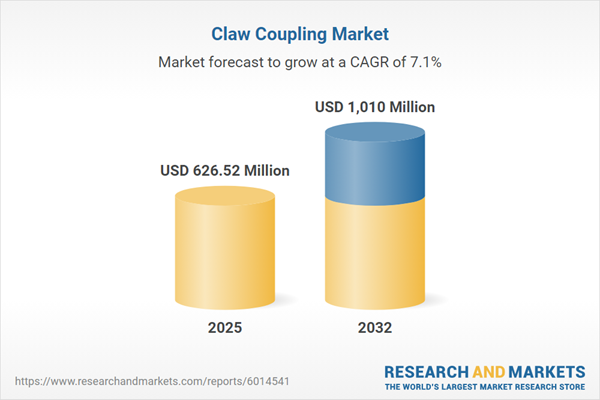Speak directly to the analyst to clarify any post sales queries you may have.
The claw coupling market enables organizations to maintain consistent power transmission performance in industrial environments, allowing senior leaders to make informed decisions about procurement, operational efficiency, and risk mitigation. Industry stakeholders rely on robust, adaptable solutions to keep pace with evolving automation and manufacturing complexities.
Claw Coupling Market Snapshot
The claw coupling market continues to advance, driven by expanding automation investments and organizational focus on resilient mechanical components. Market revenues are projected to rise from USD 584.38 million in 2024 to USD 626.52 million in 2025, reflecting a CAGR of 7.12%. Long-term industry forecasts anticipate growth reaching USD 1.01 billion by 2032. This momentum is underpinned by the demand for reliable power transmission, integration of advanced materials, and sustained capital allocation into manufacturing modernization. Increased adoption is apparent across industrial, manufacturing, and automotive applications. Organizations increasingly recognize the value of minimizing equipment downtime through high-performing coupling solutions that support long-term operational continuity.
Scope & Segmentation
Senior decision-makers will find clear segmentation and actionable sector insights contextualized for investment and supply chain strategies within the claw coupling market:
- Product Types: Double flexible, double universal, single flexible, and solid claw couplings—all engineered to improve torque handling, alignment, and reliability, addressing different operational needs across sectors.
- Applications: Utilization in automotive, chemicals, power transmission, and pulp and paper sectors—helping to prevent system failures, ensure process stability, and minimize costly interruptions.
- Material Types: Cast iron, polyurethane, and steel form the primary material spectrum, with a steady shift toward advanced alloys and polymers for environments facing extreme conditions.
- End Users: Organizations in automotive and transportation, manufacturing, energy and utilities, and oil and gas depend on efficient coupling solutions to maintain uninterrupted operation in critical, high-uptime settings.
- Distribution Channels: Procurement options include direct sales, authorized distributors, and online platforms, each facilitating strategic sourcing and responsiveness within regional supply networks.
- Regions: The Americas, Europe, Middle East and Africa, and Asia-Pacific each present unique regulatory, supply chain, and partnership considerations influencing market strategies.
- Key Companies: Leading market participants include Dixon Valve & Coupling Company, Trelleborg AB, Parker-Hannifin Corporation, Eaton Corporation plc, Elaflex Hong Kong, AVK Holding, Stucchi S.p.A., Banlaw Pty, IAN Equipment, and Hansa-Flex AG, informing supplier evaluation and competitive positioning.
Key Takeaways: Strategic Insights for Senior Decision-Makers
- Utilization of advanced alloys and elastomers enhances reliability, extending product lifespan to reduce failure risks within demanding operational environments.
- Digital monitoring and additive manufacturing technologies are transforming asset management, enabling more predictive maintenance and greater equipment uptime.
- Maintenance scheduling becomes more proactive with product designs emphasizing durability, stabilizing production and curtailing unplanned disruptions.
- Availability of coupling variants supports tailored solutions for torque and alignment challenges, optimizing selection processes for engineering teams.
- Close manufacturer-client partnerships speed technology adoption and compliance with regulatory benchmarks, resulting in solutions attuned to current and future industry standards.
- Strategic investment in robust coupling infrastructure aligns with goals of long-term plant operation and efficiency, underscoring broader operational objectives.
Tariff Impact and Supply Chain Adjustments
Recent tariffs on US steel and cast iron have introduced new cost pressures within the claw coupling market. To address these challenges, organizations are restructuring supply chains by exploring alternative materials, expanding their regional supplier base, and regularly updating procurement procedures. These steps are encouraging the development of innovative product alternatives and bolstering resilience, helping businesses mitigate price volatility and reinforce consistent supply availability.
Methodology & Data Sources
Market analysis is grounded in structured interviews with professionals specializing in engineering, procurement, and plant maintenance. All findings are supported by peer-reviewed literature and authoritative datasets, providing a robust foundation for executive-level decisions and future planning.
Why This Report Matters
- Allows executives to refine procurement strategies, respond effectively to shifting supply chains and regulations, and leverage material innovation for resilient operations.
- Enables data-driven competitive benchmarking and adoption of digital monitoring solutions, improving efficiency across business processes.
- Equips senior leaders with forward-looking insights to anticipate technology changes and adapt to global standards, supporting long-term organizational growth.
Conclusion
This report provides targeted intelligence, empowering senior decision-makers to strengthen supply chain strategies, optimize procurement, and advance competitiveness in the claw coupling market.
Additional Product Information:
- Purchase of this report includes 1 year online access with quarterly updates.
- This report can be updated on request. Please contact our Customer Experience team using the Ask a Question widget on our website.
Table of Contents
3. Executive Summary
4. Market Overview
7. Cumulative Impact of Artificial Intelligence 2025
Companies Mentioned
The companies profiled in this Claw Coupling market report include:- Dixon Valve & Coupling Company, LLC
- Trelleborg AB
- Parker-Hannifin Corporation
- Eaton Corporation PLC
- Elaflex Hong Kong Limited
- AVK Holding A/S
- Stucchi S.p.A.
- Banlaw Pty Limited
- IAN Equipment, LLC
- Hansa-Flex AG
Table Information
| Report Attribute | Details |
|---|---|
| No. of Pages | 191 |
| Published | November 2025 |
| Forecast Period | 2025 - 2032 |
| Estimated Market Value ( USD | $ 626.52 Million |
| Forecasted Market Value ( USD | $ 1010 Million |
| Compound Annual Growth Rate | 7.1% |
| Regions Covered | Global |
| No. of Companies Mentioned | 11 |









